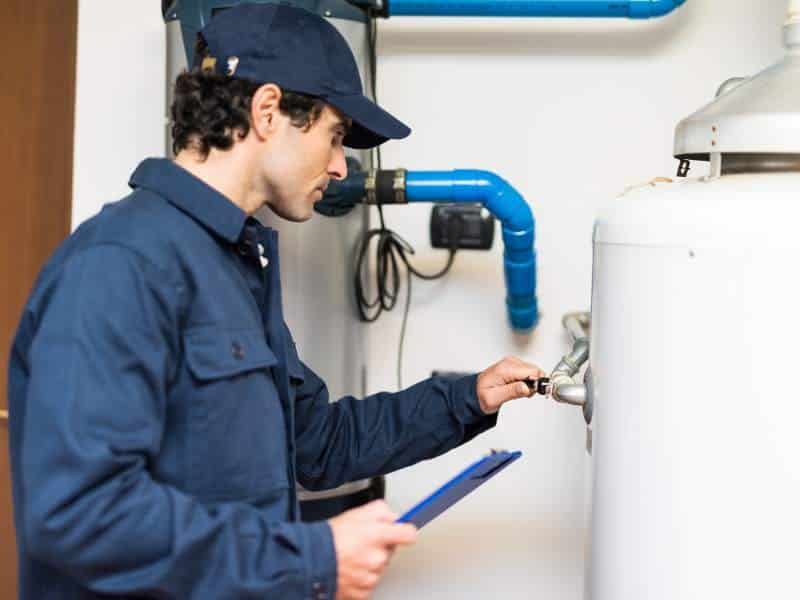Water heater leaks are more than just a nuisance; they can potentially lead to significant damage if not addressed promptly. Knowing how to handle a leaking water heater can save you time, money, and a lot of stress. In this comprehensive guide, we’ll walk you through the immediate steps to take, the likely causes, and when it’s time to call professionals like Jake Miller Plumbing for a repair or replacement.
Immediate Steps to Take for a Leaking Water Heater
Discovering a leaking water heater can be a stressful experience, but taking immediate action is key to minimizing damage and resolving the issue effectively. Before diving into the specific steps to address the problem, it’s essential to approach the situation with caution and a general plan. Knowing what to do right away can make a significant difference in both the short-term and long-term outcomes. Here’s a general overview of immediate steps to take if you find yourself facing a leaking water heater.
Turn Off the Power Supply
The first and most important step when dealing with a leaking water heater is to turn off its power supply to ensure safety during the repair process. For electric water heaters, go to your electrical panel and locate the circuit that controls the water heater. Flip the circuit breaker to the “off” position. If you have a gas-powered water heater, you’ll need to locate the gas supply valve, usually found near the bottom of the unit, and turn it to the ‘off’ position. This ensures that no electricity or gas is flowing to the unit, making it safe to proceed with further steps.
Close the Water Supply Valve
Once the power is off, the next step is to stop the water flow to the leaking unit. Most water heaters have a cold water shut-off valve located near the top of the tank. Turn this valve to the ‘off’ position to cut off the water supply, which will minimize any further leakage and water damage. If you can’t find the valve or it’s too difficult to reach, you may need to shut off the main water supply to your home temporarily.
Drain the Tank
After shutting off the water and power supply, draining the tank is the next logical step. It’s advisable to place a bucket under the drain valve at the bottom of the heater or attach a garden hose to the valve to guide the water to a drain. Open the valve carefully and allow the water to drain out. This will relieve pressure in the tank and make it easier to identify and repair the leak. Draining the tank also minimizes the risk of water damage while repairs are being carried out.
Identify the Leak Source
The final step in this initial process is identifying where the leak is coming from. This could be from various points like the tank itself, the drain valve, or the pipe connections. Inspect the unit carefully to pinpoint the source of the leak. Knowing where the water is leaking from can help in diagnosing the issue more efficiently, whether you decide to undertake the repair yourself or call in a professional. This information is invaluable for assessing the severity of the problem and determining whether a simple repair will suffice or if a complete replacement is necessary.
Common Causes of Water Heater Leaks
Understanding the common causes of water heater leaks can be beneficial in preventing future issues and determining the best course of action for repair. Here are some typical culprits to consider:
Tank Corrosion
Corrosion within the water heater tank is a leading cause of leaks. Over the years, the minerals present in water, particularly hard water, can interact with the inner lining of the tank. This interaction often leads to rust and corrosion, gradually weakening the tank’s structure until leaks develop. The issue can escalate over time and may eventually require a complete replacement of the tank. Using a water softener or periodically flushing the tank can mitigate this problem, but once the corrosion is extensive, it’s usually too late to reverse the damage.
Faulty Temperature & Pressure Relief Valve
The Temperature and Pressure Relief (T&P) valve is a safety feature designed to release excess pressure from the tank to prevent it from bursting. However, if this valve is faulty, or if the pressure inside the tank rises too high, it can result in a leak. This is an urgent issue that requires immediate attention, as an overly pressurized tank could be a safety hazard. Inspecting the T&P valve for any signs of damage or testing it to ensure it operates correctly can prevent this kind of leak. If found faulty, it should be replaced as soon as possible.
Loose Fittings and Connections
It may seem like a small issue, but loose fittings and connections can also lead to water heater leaks. Over time, vibrations from the water heater’s operation, along with natural wear and tear, can loosen these connections. This is often the easiest type of leak to fix. A visual inspection of all connections and fittings around the water heater can usually identify any that are loose. A simple tightening with a wrench is often all that’s needed to solve the problem. However, if a fitting is stripped or damaged, it may need to be replaced to ensure a secure connection.
Understanding the root cause of a leak is crucial for effective troubleshooting and repair. By being aware of these common causes, you can take preemptive measures to maintain your water heater better and act more efficiently if a leak does occur.
Benefits of Professional Water Heater Repair and Replacement
Dealing with a leaking water heater can be stressful and complicated, leaving many homeowners unsure of the next steps to take. While some may be tempted to tackle the issue themselves, there are significant advantages to entrusting this crucial job to qualified professionals. From in-depth diagnostics to expert repairs and efficient replacements, professional services offer an array of benefits designed to resolve your water heater issues effectively and extend the lifespan of your unit. Here we’ll delve into why professional intervention is often the best course of action for handling water heater leaks.
Cost-Efficiency
A leaking water heater is not just a one-time expense; it can elevate your water and energy bills. Professional repairs ensure a long-term solution, saving you money in the long run.
Safety
Incorrect DIY repairs can risk both your safety and the proper functioning of the heater. Professionals adhere to safety standards and have the expertise to get the job done correctly.
Peace of Mind
Knowing that your water heater is repaired by a certified technician adds a layer of assurance. Plus, you can count on professional warranties for added peace of mind.
Preventive Measures for Future Leaks
Prevention is better than cure. Regular maintenance like checking for rust, testing the pressure relief valve, and draining sediment can prolong the life of your water heater and reduce the likelihood of leaks.
Contact the Experts
A leaking water heater is a problem that requires immediate attention. While some issues can be addressed with quick fixes, it’s always best to consult professionals for a comprehensive solution. Jake Miller Plumbing specializes in water heater repair and replacement, ensuring that you’re not left in the cold—literally.
Don’t let a leaking water heater disrupt your life. Contact us today for an expert consultation and take the first step towards resolving this pressing issue. Remember, a well-functioning water heater is integral to a comfortable and efficient home.
Contact Jake Miller Plumbing to schedule your water heater service today. With our expertise, your home will be back to its cozy self in no time.
Disclaimer: Always consult a professional for water heater issues, as improper handling can be hazardous. This blog is intended for informational purposes only.

